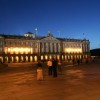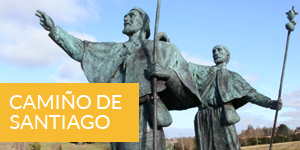- Accede I
- Regístrate I
- carrito
La Ciudad cosmopolita del Medievo
La peregrinación a Compostela adquirió ya desde la fundación de la ciudad una gran importancia. Santiago se convertirá en el foco espiritual de la Europa occidental y en receptora de diversas corrientes de cultura, pero también de tesoros que enriquecen el santuario. Atraídos por ellos, los normandos realizaron repetidas incursiones por la ría de Arousa, aunque la invasión de la ciudad llegaría con los musulmanes, que, comandados por Almanzor, devastaron la urbe en el año 997, aunque respetaron el sepulcro. Con la reconstrucción se produce la primera expansión urbana de Santiago y se construye una nueva fortificación que define el perímetro de la ciudad histórica que hoy conocemos. En el año 1075 comienza la construcción de la gran catedral románica.
En 1099 accede al episcopado Diego Xelmírez, el gran impulsor de la sede compostelana y transformador de la ciudad. Figura clave de la política castellano-leonesa, su ánimo constructor lo dirigió a la catedral, al palacio Arzobispal y a las iglesias que van a acoger las nuevas reliquias traídas por él, entre ellas las de Santa Susana, segunda patrona de la ciudad.
Es tiempo de luchas entre el pueblo y el señorío arzobispal, de las que son protagonistas la reina doña Urraca, el obispo, los canónigos y abates, los caballeros y los burgueses. Desde el primer año de su episcopado, la construcción de la catedral recibe un impulso definitivo cuando Xelmírez encarga las obras al Maestro Esteban, que las termina en 1125. En ese instante, la catedral y la ciudad crecen al mismo tiempo. Cuando muere Xelmírez en 1140, la estructura de la ciudad medieval que llegó hasta nuestros días, está ya definida.
En 1168 se inicia la segunda gran campaña de edificación de la catedral, encargándole las obras al maestro Mateo, que es el artista más importante de su tiempo en la Península Ibérica. En Santiago, su figura está ligada a dos conjuntos monumentales de la catedral: el Coro Pétreo y el Pórtico de la Gloria. Finalizado en 1188, el Pórtico de la Gloria traspasó las posibilidades estéticas de su época y señaló nuevos horizontes, hasta el punto de que hoy podemos considerarlo como una de las obras maestras del arte románico y universal.
En el siglo XIII la catedral se muestra en todo su esplendor, atrayendo cada vez a más fieles de toda la cristiandad y reforzando las peregrinaciones a la ciudad. En este tiempo está ya definido el Camino Francés, el más importante de los que llegan a Compostela. Las peregrinaciones dan lugar a un fenómeno decisivo en la vida de la ciudad: la instalación de los conventos de las órdenes mendicantes, por lo general en las puertas de la ciudad. Conventos como San Francisco, Santo Domingo, Santa Clara o Belvís, crean nuevos núcleos que determinan la estructura de la ciudad histórica situada extramuros. A lo largo de la Baja Edad Media, Compostela se fue conformando también como un importante núcleo industrial y comercial: calles como la de Caldeirería, Moeda Vella, Acibechería o Concheiros testimonian la existencia de gremios ricos y florecientes.
Los siglos XIV y XV fueron tiempos de luchas de la burguesía santiaguesa contra el poder de la Iglesia, mientras la mitra compostelana sufre una importante degradación económica. La familia Fonseca, que da tres arzobispos a la ciudad, rige sus destinos desde esa época de profundas transformaciones del final de la Edad Media. En 1495 se funda el Colegio de Estudiantes Pobres, germen de la actual Universidad instituida por Alonso de Fonseca III en 1525. Desde ese momento, Santiago empieza a adquirir un fuerte carácter de ciudad académica y estudiantil.

















